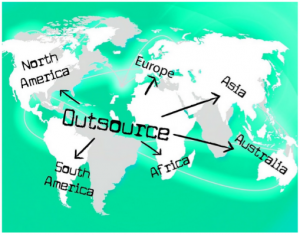3.3 Sourcing and Outsourcing of Goods, Manufacturing and Services
Learning Objective
2. Introduce the concepts of sourcing and outsourcing of goods, manufacturing and services.
Modern businesses evolve simply from domestic supply of products to global sourcing and outsourcing goods, manufacturing, and services. It is clear that companies cannot manufacture and do all products and services for running a business and hold a competitive position in the market. That is why many organizations use sourcing and outsourcing strategies and become globally competitive. Other benefits accrued include cost reduction, increasing efficiency by meeting customer demands on time, taking advantage of different time zones, accessing cutting-edge technology, cheap cost of labour, increase innovation and share expertise, improve quality of products/services, access to talents and experts, and so forth. Actual examples of big companies outsourcing include Google, Apple, Skype, Alibaba, etc. Let's delve deeper into the definitions of sourcing and outsourcing of goods, manufacturing and services.
Sourcing
Consider This
The following material is adapted from Global Sourcing and Distribution by Babu John Mariadoss (n.d.). under a Creative Commons Attribution-NonCommercial-ShareAlike License 4.0.
Global sourcing refers to buying the raw materials or components that go into a company’s products from around the world, not just from the headquarters’ country. For example, Starbucks buys its coffee from locations like Colombia and Guatemala. The advantages of global sourcing are quality and lower cost. Global sourcing is possible to the extent that the world is flat—for example, buying the highest-quality cocoa beans for making chocolate or buying aluminum from Iceland, where it’s cheaper because it’s made using free geothermal energy.
When making global-sourcing decisions, firms face a choice of whether to sole-source (i.e., use one supplier exclusively) or to multisource (i.e., use multiple suppliers). The advantage of sole sourcing is that the company will often get a lower price by giving all of its volume to one supplier. If the company gives the supplier a lot of business, the company may have more influence over the supplier for preferential treatment. For example, during a time of shortage or strained capacity, the supplier may give higher quantities to that company rather than to a competitor as a way of rewarding the company’s loyalty.
On the other hand, using multiple suppliers gives a company more flexibility. For instance, if there’s a natural disaster or other disruption at one of their suppliers, the company can turn to its other suppliers to meet its needs. For example, when Hurricane Mitch hit Honduras with 180-mile-per-hour winds, 70 to 80 percent of Honduras’s infrastructure was damaged and 80 percent of its banana crop was lost. Both Dole Food Company and Chiquita bought bananas from Honduras, but Dole relied more heavily on bananas from Honduras than from other countries. As a result, Dole lost 25 percent of its global banana supply, but Chiquita lost only 15 percent.
Sole-Sourcing Advantages
- Price discounts based on higher volume
- Rewards for loyalty during tough times
- Exclusivity brings differentiation
- Greater influence with a supplier
Sole-Sourcing Disadvantages
- Higher risk of disruption
- Supplier has more negotiating power on price
Multisourcing Advantages
- More flexibility in times of disruption
- Negotiating lower rates by pitting one supplier against another
Multisourcing Disadvantages
- Quality across suppliers may be less uniform
- Less influence with each supplier
- Higher coordination and management costs
Whichever sourcing strategy a company chooses, it can reduce risk by visiting its suppliers regularly to ensure the quality of products and processes, the financial health of each supplier, and the supplier’s adherence to laws, safety regulations, and ethics.
(Mariadoss, n.d.) CC-BY-NC-SA-4.0
Outsourcing
Outsourcing

As defined by Cambridge Dictionary (2022):
Outsourcing is the process or a situation when the company employs a third-party provider or organization to do some work instead of using its staff or resources. Sourcing is a process of gaining goods or services from a particular place.
Simply, organizations select suppliers worldwide to provide goods for running business so-called sourcing. The difference between sourcing and outsourcing is that sourcing supplies goods/products for running a business; on the other hand, outsourcing transfers a firm's function to the third-party provider or external service provider. A lot of Canadian companies, as well as the Canadian government, use outsourcing technology. For example, according to Forrester Research (2020), the Canadian government and businesses spent 15 billion dollars on technology outsourcing in 2021 (Forrester Research, 2020). View this graph, Technology Outsourcing Industry Spending by Business and Government in Canada from 2016 to 2021 for a further breakdown.
Table 3.1
Advantages and Disadvantages of Outsourcing
| Advantages | Disadvantages |
|---|---|
| Lower costs; | Expose confidential information and technology; |
| differentiate products; | hidden costs; |
| production capacity; | exchange rate fluctuations; |
| meet customer demands; | lack of customer focus; |
| efficient replenishment; | cost of transactions can be raised; |
| focus on the core competencies; | wrong partners; |
| build innovative products or services; | risk of cultural differences; |
| effective and efficient service; | risk of poor-quality finished products; |
| increase value by bringing capabilities and expertise; | delay in delivering goods or services. |
| reduce operational and production costs; | |
| being adaptable for changing market conditions and preferences; | |
| increase human resources; | |
| low cost of labour |
Video: Why Outsourcing is Bad for Business (3:37)
As countries like China and India become leaders in manufacturing the costs of their expertise rises diminishing their advantage against US counterparts. Adversely, convoluted and increasingly risky supply chains dependent on inexperienced vendors have turned once stable brands like Boeing, into the perfect "reshoring" case study.
Media 3.3 Why Outsourcing is Bad for Business [Video]. Minute MBA by OnlineMBA. (URL: https://www.youtube.com/watch?v=V7fsEIp2r_8)com.
Outsourcing of Manufacturing
Globalization has significantly improved businesses by increasing the availability of labour globally and production flexibility. In addition, labour costs in many countries are cheap, which helps companies move their production process to third-party or external providers with whom the firm has a contract. As a result, the firm has gotten a lot of advantages, such as access to specialized resources and reduced fixed costs. For example, an airplane can be split into thousands of parts and produced in many geographic locations.
Consider This
A real example of outsourcing manufacturing is described in the following section from the Introduction to Business reading: “Outsourcing” by Linda Williams and Lumen Learning under a Creative Commons Attribution-NonCommercial-ShareAlike License 4.0 .
PowerSki’s Web site states that “PowerSki International has been founded to bring a new watercraft, the PowerSki Jetboard, and the engine technology behind it, to market.”[1] That goal was reached in May 2003, when the firm emerged from a lengthy design period. Having already garnered praise for its innovative product, PowerSki was ready to begin mass-producing Jetboards. At this juncture, the management team made a strategic decision that’s not uncommon in manufacturing today.
Rather than producing Jetboards in-house, they opted for outsourcing: having outside vendors manufacture the engines, fiberglass hulls, and associated parts. Assembly of the final product took place in a manufacturing facility owned by All American Power Sports in Moses Lake, Washington. This decision does not mean that the company relinquished control over quality; in fact, every component that goes into the PowerSki Jetboard is manufactured to exact specifications set by PowerSki.
One advantage of outsourcing its production function is that the management team can thereby devote its attention to refining its product design and designing future products. However, as processes or pieces of a process are outsourced companies have legitimate concerns about quality standards being met and maintained at the outsourced location. The decision whether or not to outsource often comes down to identifying organizations that can meet and maintain the standards set by the company and the customer.
Figure 3.4
Outsourcing in the Manufacturing Sector

Understandably, outsourcing is becoming an increasingly popular option among manufacturers. For one thing, few companies have either the expertise or the inclination to produce everything needed to make a product. Today, more firms, like PowerSki, want to specialize in the processes that they perform best—and outsource the rest. Like PowerSki, they also want to take advantage of outsourcing by linking up with suppliers located in regions with lower labor costs.(Williams, n.d.). CC-BY-NC-SA-4.0
Outsourcing of Services
Outsourcing services are essential for companies, governments, countries, and the world. Globalization allows organizations to be competitive and move data cost-effectively and very fast. In addition, technological advances help continue to grow to outsource services significantly. For example, according to Statista (2019), IT outsourcing services continue to grow steadily, and revenue of these services in Canada in 2021 accounted for approximately 500.97 million U.S. Dollars while the significant part is 7,439.02 million U.S. Dollars for IT-infrastructure outsourcing (Statista, January 22, 2019). View graph IT-outsourcing services market revenue in Canada from 2016 to 2021, by segment (in million U.S. Dollars) [chart description].
There are a few outsourcing services such as administration, infrastructure, and knowledge. Infrastructure services include communications services, information security, media and content, data processing, developing applications, and data storage. Administration services consist of the following: business processes, public administration, security, procurement, accounting, finance and so forth. Finally, the knowledge segment includes product and service developments, research, analytics, inventory management, insurance processing, software design.
Check Your Understanding
Introduce the concepts of sourcing and outsourcing of goods, manufacturing and services.
Answer the questions below to see how well you understand the topics covered above. You can retake it an unlimited number of times.
Use this quiz to check your understanding and decide whether to (1) study the previous section further or (2) move on to the next section.
Interactive activity unavailable in this format
Text-based alternative to interactive activity available in Chapter 3.7.
Overall Activity Feedback
Modern businesses evolve simply from domestic supply of products to global sourcing and outsourcing goods, manufacturing, and services. It is clear that companies cannot manufacture and do all products and services for running a business and hold a competitive position in the market. That is why many organizations use sourcing and outsourcing strategies and become globally competitive. Other benefits accrued include cost reduction, increasing efficiency by meeting customer demands on time, taking advantage of different time zones, accessing cutting-edge technology, cheap cost of labour, increasing innovation and sharing expertise, improving quality of products/services, access to talents and experts, and so forth. Globalization has significantly improved businesses by increasing the availability of labour globally and production flexibility. In addition, labour costs in many countries are cheap, which helps companies move their production process to third-party or external providers with whom the firm has a contract. As a result, the firm has gotten a lot of advantages, such as access to specialized resources and reduced fixed costs.
Media Attributions and References
Gibson, J. (n.d.). [Outsource]. [Photograph]. Pixabay. https://pixabay.com/illustrations/outsource-freelance-contractor-1345109/
Minute MBA by OnlineMBA.com. (2013, May 28). Why outsourcing is bad for business [Video]. YouTube. https://www.youtube.com/watch?v=V7fsEIp2r_8


